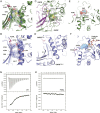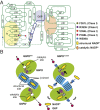Long-range structural defects by pathogenic mutations in most severe glucose-6-phosphate dehydrogenase deficiency
- PMID: 33468660
- PMCID: PMC7848525
- DOI: 10.1073/pnas.2022790118
Long-range structural defects by pathogenic mutations in most severe glucose-6-phosphate dehydrogenase deficiency
Abstract
Glucose-6-phosphate dehydrogenase (G6PD) deficiency is the most common blood disorder, presenting multiple symptoms, including hemolytic anemia. It affects 400 million people worldwide, with more than 160 single mutations reported in G6PD. The most severe mutations (about 70) are classified as class I, leading to more than 90% loss of activity of the wild-type G6PD. The crystal structure of G6PD reveals these mutations are located away from the active site, concentrating around the noncatalytic NADP+-binding site and the dimer interface. However, the molecular mechanisms of class I mutant dysfunction have remained elusive, hindering the development of efficient therapies. To resolve this, we performed integral structural characterization of five G6PD mutants, including four class I mutants, associated with the noncatalytic NADP+ and dimerization, using crystallography, small-angle X-ray scattering (SAXS), cryogenic electron microscopy (cryo-EM), and biophysical analyses. Comparisons with the structure and properties of the wild-type enzyme, together with molecular dynamics simulations, bring forward a universal mechanism for this severe G6PD deficiency due to the class I mutations. We highlight the role of the noncatalytic NADP+-binding site that is crucial for stabilization and ordering two β-strands in the dimer interface, which together communicate these distant structural aberrations to the active site through a network of additional interactions. This understanding elucidates potential paths for drug development targeting G6PD deficiency.
Keywords: G6PD deficiency; NADP+; enzymopathy; hemolytic anemia; structural defects.
Copyright © 2021 the Author(s). Published by PNAS.
Conflict of interest statement
The authors declare no competing interest.
Figures





Similar articles
-
Human glucose-6-phosphate dehydrogenase: the crystal structure reveals a structural NADP(+) molecule and provides insights into enzyme deficiency.Structure. 2000 Mar 15;8(3):293-303. doi: 10.1016/s0969-2126(00)00104-0. Structure. 2000. PMID: 10745013
-
Stabilization of glucose-6-phosphate dehydrogenase oligomers enhances catalytic activity and stability of clinical variants.J Biol Chem. 2022 Mar;298(3):101610. doi: 10.1016/j.jbc.2022.101610. Epub 2022 Jan 20. J Biol Chem. 2022. PMID: 35065072 Free PMC article.
-
Functional and Biochemical Characterization of Three Recombinant Human Glucose-6-Phosphate Dehydrogenase Mutants: Zacatecas, Vanua-Lava and Viangchan.Int J Mol Sci. 2016 May 21;17(5):787. doi: 10.3390/ijms17050787. Int J Mol Sci. 2016. PMID: 27213370 Free PMC article.
-
An Overall View of the Functional and Structural Characterization of Glucose-6-Phosphate Dehydrogenase Variants in the Mexican Population.Int J Mol Sci. 2023 Aug 11;24(16):12691. doi: 10.3390/ijms241612691. Int J Mol Sci. 2023. PMID: 37628871 Free PMC article. Review.
-
G6PD deficiency: the genotype-phenotype association.Blood Rev. 2007 Sep;21(5):267-83. doi: 10.1016/j.blre.2007.05.002. Epub 2007 Jul 3. Blood Rev. 2007. PMID: 17611006 Review.
Cited by
-
Evaluation of Three Mutations in Codon 385 of Glucose-6-Phosphate Dehydrogenase via Biochemical and In Silico Analysis.Int J Mol Sci. 2024 Nov 22;25(23):12556. doi: 10.3390/ijms252312556. Int J Mol Sci. 2024. PMID: 39684266 Free PMC article.
-
Human papillomavirus-16 E6 activates the pentose phosphate pathway to promote cervical cancer cell proliferation by inhibiting G6PD lactylation.Redox Biol. 2024 May;71:103108. doi: 10.1016/j.redox.2024.103108. Epub 2024 Mar 1. Redox Biol. 2024. PMID: 38457903 Free PMC article.
-
Case Report: Drug-Induced Immune Haemolytic Anaemia Caused by Cefoperazone-Tazobactam/ Sulbactam Combination Therapy.Front Med (Lausanne). 2021 Aug 12;8:697192. doi: 10.3389/fmed.2021.697192. eCollection 2021. Front Med (Lausanne). 2021. PMID: 34485334 Free PMC article.
-
Structural basis of the allosteric regulation of cyanobacterial glucose-6-phosphate dehydrogenase by the redox sensor OpcA.Proc Natl Acad Sci U S A. 2024 Dec 10;121(50):e2411604121. doi: 10.1073/pnas.2411604121. Epub 2024 Dec 6. Proc Natl Acad Sci U S A. 2024. PMID: 39642196 Free PMC article.
-
Allosteric role of a structural NADP+ molecule in glucose-6-phosphate dehydrogenase activity.Proc Natl Acad Sci U S A. 2022 Jul 19;119(29):e2119695119. doi: 10.1073/pnas.2119695119. Epub 2022 Jul 12. Proc Natl Acad Sci U S A. 2022. PMID: 35858355 Free PMC article.
References
-
- Minucci A., et al. , Glucose-6-phosphate dehydrogenase (G6PD) mutations database: Review of the “old” and update of the new mutations. Blood Cells Mol. Dis. 48, 154–165 (2012). - PubMed
-
- Luzzatto L., Nannelli C., Notaro R., Glucose-6-phosphate dehydrogenase deficiency. Hematol. Oncol. Clin. North Am. 30, 373–393 (2016). - PubMed
-
- Nkhoma E. T., Poole C., Vannappagari V., Hall S. A., Beutler E., The global prevalence of glucose-6-phosphate dehydrogenase deficiency: A systematic review and meta-analysis. Blood Cells Mol. Dis. 42, 267–278 (2009). - PubMed
Publication types
MeSH terms
Substances
Grants and funding
LinkOut - more resources
Full Text Sources
Other Literature Sources
Medical
Miscellaneous

